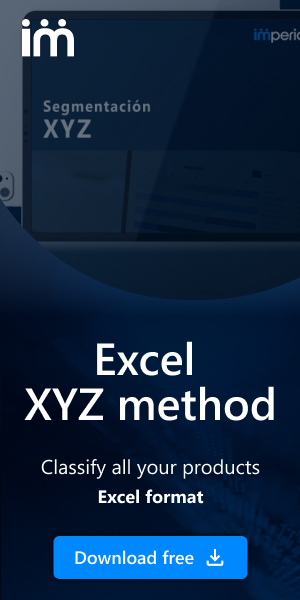Inventory management is key in supply chain management, playing a crucial role in the operational efficiency and profitability of companies. The ability to effectively manage inventories can make the difference between a company's success and failure.
In this blog post, we will explore in-depth what inventory management is, the different types of inventories, the benefits of efficient management, the strategies and methods employed, the technological tools available, best practices, common challenges, and the future of this discipline. Keep reading!
What is Inventory Management?
Inventory management is the process by which a company supervises and controls the flow of goods, from the acquisition of raw materials to the delivery of finished products to the customer. This process includes activities such as demand forecasting, order management, storage, and inventory monitoring.
The main goal is to maintain an appropriate balance between supply and demand, ensuring that there are enough products available to meet customer needs without incurring excessive inventory that may generate unnecessary costs.

Types of Inventories
To carry out good inventory management, we must first understand the different types of inventories that can be found in a company. Storing raw materials is not the same as storing work-in-progress or finished goods. If we want to optimize our inventory management, we must consider the particularities of each type of inventory.
Raw Materials
Raw materials are the basic components used in the production of goods. These materials can be sourced from external suppliers or produced internally. Efficient management of raw materials is essential to avoid disruptions in the production process and to ensure that finished products meet quality standards. Effective inventory management will maintain the necessary level of raw materials to produce the goods that our customers demand without incurring excess inventory.
Work-in-Progress
Work-in-progress includes those items that are in an intermediate stage of production. This inventory includes goods that are being assembled or manufactured but are not yet ready for sale. Managing work-in-progress is crucial to optimizing the production flow and minimizing cycle time, avoiding bottlenecks, and ensuring a smooth transition to the finished product.
Finished Goods
Finished goods are those that have completed the production process and are ready to be sold to customers. Managing finished goods involves ensuring that there is enough inventory to meet customer demand without overstocking, which could result in storage costs and obsolescence risks.
Benefits of Efficient Inventory Management
Companies that have efficient inventory management obtain various benefits. Among these benefits, cost reduction, optimization of storage space, and reduction of waste are particularly noteworthy.
Cost Reduction
Efficient inventory management significantly contributes to cost reduction. By optimizing the amount of inventory stored, companies can minimize the costs associated with storage, such as space rental, energy, and security. Additionally, capital costs associated with excess inventory that remains idle for long periods are reduced.
Storage Space Optimization
Proper inventory management allows for optimal use of storage space. By avoiding the excessive storage of products, companies can better utilize available space, reduce storage costs, and improve operational efficiency. This also enables better organization and accessibility of products, facilitating inventory control and monitoring.
Reduction of Losses and Waste
Effective inventory management helps minimize losses and waste associated with obsolete or deteriorated products. By implementing strategies such as inventory turnover analysis and product lifecycle management, companies can ensure that products are used within their optimal sales period, thus reducing the risk of value loss.

Inventory Management Strategies and Methods
If we want our company to manage inventory well, we can apply different strategies and methods. Below, we highlight some of the most commonly used methods, such as the Reorder Point (ROP) system, Just In Time, or ABC analysis.
Reorder Point (ROP) System
The Reorder Point (ROP) system is a strategy used to determine when a new inventory order should be placed. This system is based on calculating the inventory level that, when reached, triggers a replenishment order. The ROP is determined by considering factors such as average demand, lead time, and a safety stock to cover potential demand fluctuations.
Just In Time
The Just In Time (JIT) method is an inventory management strategy that aims to minimize inventory on hand by receiving materials just as they are needed for production. This approach reduces storage costs and improves operational efficiency by eliminating excess inventory and ensuring that resources are available when needed.
ABC Analysis
The ABC analysis is an inventory management technique that classifies products into three categories (A, B, and C) based on their importance and value. Category A products are the most valuable and require stricter management, while Category C products are the least costly and can be managed with less rigorous control. This classification allows companies to prioritize their efforts and resources on the most critical products for their business.
Perpetual vs. Periodic Inventory
Perpetual inventory is a strategy where inventory is continuously updated in real-time, allowing for precise and up-to-date stock control. On the other hand, periodic inventory involves conducting inventory counts at regular intervals, which may result in less accuracy and a higher risk of discrepancies. The choice between these methods depends on the specific needs and capabilities of each company.

Technological Tools for Inventory Management
In addition to strategies and methods, there are also various technological tools available that can help us improve our company's inventory management. Some of these tools include inventory management software, radio frequency identification systems, barcoding, and warehouse robotics.
Inventory Management Software
Inventory management software is an essential tool that allows companies to efficiently monitor and control their inventories. These systems provide functionalities such as real-time inventory tracking, automated ordering, warehouse management, and detailed reporting. By integrating these tools with other business systems, such as ERP, companies can achieve a holistic and coordinated view of their operations.
Radio Frequency Identification (RFID) Systems
Radio Frequency Identification (RFID) systems use electronic tags to track and manage inventories. These tags contain information that can be read by scanning devices, allowing for precise and automated product tracking. RFID technology enhances inventory visibility, reduces errors, and facilitates the management of large volumes of products.
Barcoding
Barcoding is a widely used technology in inventory management. Each product is identified by a unique barcode that can be scanned to record and track its movement. This technology simplifies the process of inventory intake and outflow, reduces manual errors, and improves operational efficiency.
Automation and Robotics in Warehouses
Automation and robotics are revolutionizing inventory management in warehouses. Automated Storage and Retrieval Systems (AS/RS) and Autonomous Mobile Robots (AMR) can perform repetitive and physically demanding tasks, such as picking and storing products. These technologies increase the speed and accuracy of operations, reduce labor costs, and improve workplace safety.

Best Practices for Optimal Inventory Management
By combining strategies and technology, we can achieve efficient inventory management. However, we can also include a series of best practices to make reaching this goal much easier.
Demand Forecasting
Accurate demand forecasting is fundamental to effective inventory management. Using statistical techniques and data analysis, companies can anticipate future needs and adjust their inventory levels accordingly. Accurate forecasting helps avoid overstocking and stockouts, optimizing resources and improving customer satisfaction. To do this, it is advisable to use demand planning software that use historical data and combine it with advanced algorithms to quickly make precise forecasts.
Periodic Audits and Controls
Conducting periodic inventory audits and controls is essential to maintaining the accuracy and integrity of inventory records. These audits can identify discrepancies, losses, or damages and allow for timely correction of issues. Implementing a regular audit program helps maintain confidence in inventory management systems and ensures that data is reliable.
Supplier Relationships and Lead Time Optimization
Maintaining strong relationships with suppliers and optimizing lead times are key to effective inventory management. Collaborating closely with suppliers ensures timely delivery of materials and reduces the risk of stockouts. Additionally, optimizing lead times through better communication and planning improves supply chain efficiency and minimizes disruptions.
Challenges in Inventory Management
Despite the best efforts, companies often face challenges in inventory management, including demand variability, supply chain disruptions, and high storage costs.
Demand Variability
Demand variability is one of the main challenges in inventory management. Unexpected fluctuations in demand can lead to stockouts or overstocking, negatively impacting customer service and profitability. Companies must develop strategies to address this variability, such as flexible inventory policies, collaboration with suppliers, and the use of advanced demand forecasting tools.
Supply Chain Disruptions
Supply chain disruptions, such as supplier delays, transportation issues, or external factors like natural disasters, can negatively affect inventory management. Companies must have contingency plans in place to address these disruptions and ensure continuity of supply. Implementing a robust supplier network, diversifying sources, and establishing safety stocks are effective measures to mitigate the impact of supply chain disruptions.
Storage Costs
High storage costs represent another challenge in inventory management. Storing large quantities of products involves expenses such as warehouse rental, energy, security, and insurance. Additionally, excess inventory can lead to obsolescence and product waste. Companies must balance maintaining adequate inventory levels to meet demand and minimizing storage costs through efficient inventory management practices.
Future of Inventory Management
The future of inventory management is closely linked to the advancement of technologies such as artificial intelligence, machine learning, the Internet of Things, and blockchain. These technologies will continue to transform the way companies manage their inventories, enabling greater precision, efficiency, and adaptability.
In conclusion, efficient inventory management is essential for the success of any company. By understanding the types of inventories, applying appropriate strategies, using technological tools, and following best practices, companies can optimize their inventory management and achieve a competitive advantage in the market.
If you want to learn more about inventory management and how to implement these strategies in your company, contact us to provide you with a personalized solution tailored to your needs.

Enter your email and download the content
In supply chain management, identifying key elements that require special attention can make the difference between success and failure.





























































 Imperia_thumbnail.jpg)





















